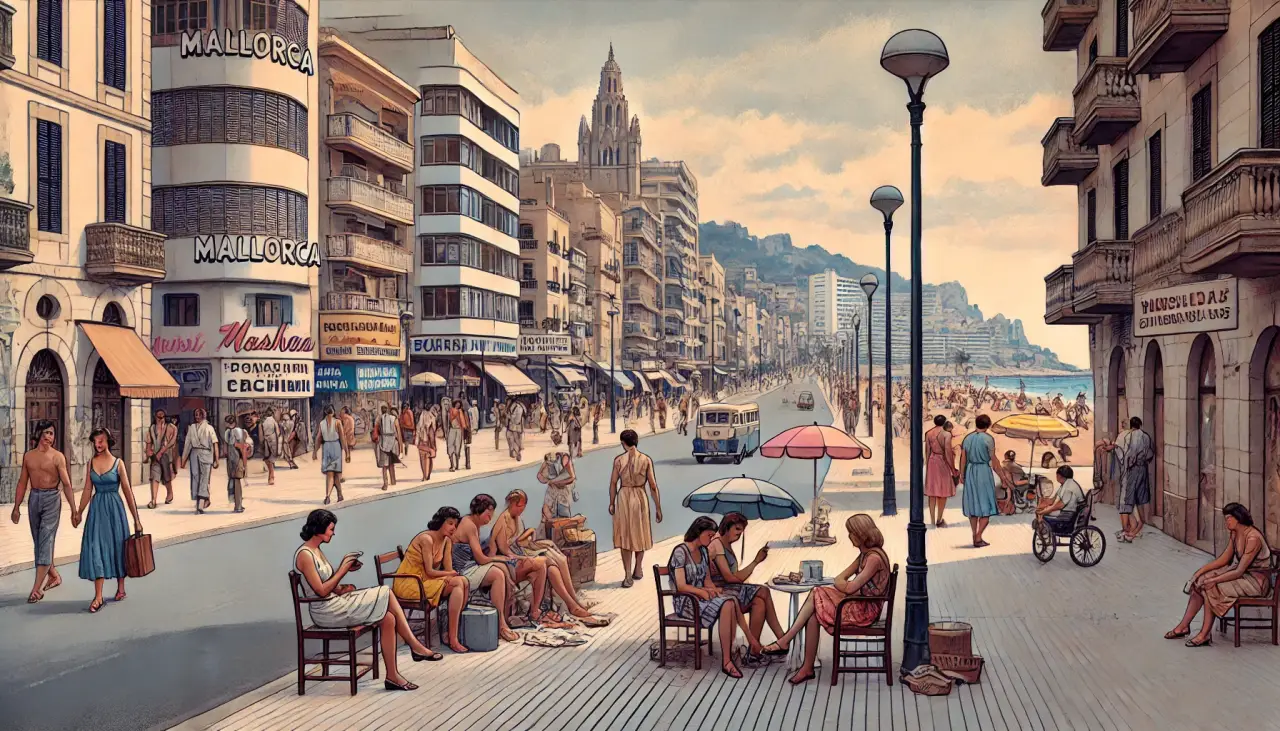In the final days of the Francoist regime, Rosa Arregui shed light on a seldom-discussed topic: the intersection of prostitution, tourism, and economic challenges in Mallorca.
Her groundbreaking study, presented in 1975, was the first to link these elements, highlighting the complex social landscape that was unfolding on the island as the service sector boomed and a wave of feminism began to emerge.
Arregui’s report, titled “The Misfit and Marginalized Woman,” delved into the discriminatory conditions women faced at the time. Commissioned by the United Nations as part of the International Year of Women, her research in the Balearic Islands revealed the extent to which economic hardship and migration spurred by tourism contributed to the marginalization of women, often leading them into prostitution.
At that time, prostitution was considered a public order offense under Franco’s laws. Women were arrested and brought before the Special Court for Dangerousness and Social Rehabilitation, while their clients faced no legal repercussions.
Arregui documented 365 cases of women engaged in prostitution, noting their ages and provinces of origin, most being young women in their 20s and 30s who had migrated to Mallorca from other parts of Spain.
She described how unskilled workers flooded the island to capitalize on the booming tourism industry, only to find themselves marginalized due to limited job opportunities and high living costs—issues that still resonate today.
Mallorca’s expanding tourism industry created a demand for service workers, drawing waves of internal migrants and triggering a series of social shifts. Amid this growth, there was a darker side—prostitution became rampant, and reports suggested that the arrival of foreign ships, including the American Sixth Fleet, exacerbated the issue.
It was a time when, according to Arregui, the island witnessed “shipments of women” to satisfy the sexual demands of sailors, creating a “hotbed of prostitution” that coincided with the arrival of tourists.
Today, the connection between tourism and prostitution on the island is still evident. Organizations like Doctors of the World have reported that cases of prostitution double during the high tourism season.
The increased activity contributes to the invisibility and clandestinity of prostitution, making it difficult to address and resolve. Recent figures from the Balearic Islands’ Department of Social Services reveal that the prostitution industry generates an estimated 70 million euros annually.
In 2023, non-governmental organizations Casal Petit, the Red Cross, and Doctors of the World assisted 1,390 victims of prostitution in Palma alone. Of these, 361 were identified as victims of human trafficking for sexual exploitation—a number that has risen since the previous year.
Arregui’s study, despite being published nearly 50 years ago, remains relevant today as it brought attention to the vulnerable position of women in a rapidly changing society. At a time when the feminist movement was in its infancy, Arregui called for measures to protect marginalized women and proposed initiatives such as creating support services for migrant women, promoting equal opportunities for daughters and sons, and providing special protection for single mothers.
Her study was featured on the back cover of the local newspaper Diario Balear on June 1, 1975, sparking public debate and making headlines. The response to the article was so intense that journalist Mateo Cladera, who conducted the interview, was approached by people on the street to discuss the piece.
Today, reports such as the Macro-study on Trafficking, Sexual Exploitation, and Prostitution of Women by the Government Delegation against Gender Violence position the Balearic Islands as the region with the highest number of women in prostitution, representing 1.21% of the adult female population—more than double the national average.
As Arregui pointed out decades ago, education and awareness remain crucial in addressing the root causes. “As long as there are consumers, there will be prostitution,” she reflected on the persistent issue.
Arregui’s pioneering research and tireless efforts to promote gender equality have had a lasting impact, sparking conversations that continue to this day. Her work serves as a reminder of the challenges women face in tourism-driven economies and the importance of social support systems to protect those most vulnerable.
Prostitution in Europe
Prostitution in Europe varies widely across countries in terms of legality, regulation, and social impact. While some European nations have legalized and regulated the industry to provide protections for sex workers, others have criminalized it entirely or targeted only the demand side by penalizing clients. These differing approaches create a complex landscape that intersects with issues of human trafficking, labor rights, public health, and gender equality.
In countries like Germany and the Netherlands, prostitution is legal and regulated, with sex workers benefiting from labor protections, health insurance, and pension contributions. Most recently this summer, Euro 2024 has significantly boosted the German economy, with the sex industry in Germany being a notable beneficiary.
These countries argue that regulation reduces the risks associated with the industry and provides a safer working environment. However, critics argue that legalizing the industry may attract human trafficking networks and increase exploitation.
Sweden, Norway, and France have adopted the “Nordic Model,” which criminalizes the purchase of sexual services but decriminalizes the sale of such services. The aim of this model is to reduce demand and discourage the exploitation of vulnerable people. Advocates of this model believe that it helps curb sex trafficking and protects sex workers by not prosecuting them. However, opponents argue that it pushes the industry underground, making it harder for sex workers to seek support and protection.
In Spain, prostitution exists in a legal gray area. While not illegal, it is largely unregulated, leading to concerns about exploitation and the involvement of organized crime. Prostitution is often associated with migration and economic hardship, with many sex workers coming from Latin America and Eastern Europe. The lack of regulation makes it difficult to protect sex workers’ rights and reduce human trafficking.
The situation in the Balearic Islands, particularly Mallorca, reflects many of these broader European trends. As a prominent tourist destination, Mallorca’s high season leads to increased demand for sex work, often coinciding with the arrival of foreign workers and seasonal migrants. Local organizations like Doctors of the World have highlighted how tourism and prostitution are interconnected, with the high season seeing a sharp rise in prostitution-related activities.
Moreover, the COVID-19 pandemic exposed the vulnerabilities of sex workers in Europe, with many losing their source of income and lacking access to social safety nets. The pandemic led to renewed discussions about how best to protect the rights and health of sex workers, with some advocates pushing for full decriminalization as a solution that would enable better regulation and support.
In summary, prostitution in Europe is a multifaceted issue that reflects broader societal and policy challenges. The interplay between tourism and prostitution, as seen in Mallorca, is a microcosm of the complex dynamics at play across the continent. Addressing the challenges faced by sex workers requires a nuanced understanding of local contexts, combined with a concerted effort to tackle human trafficking, ensure labor rights, and promote gender equality.



